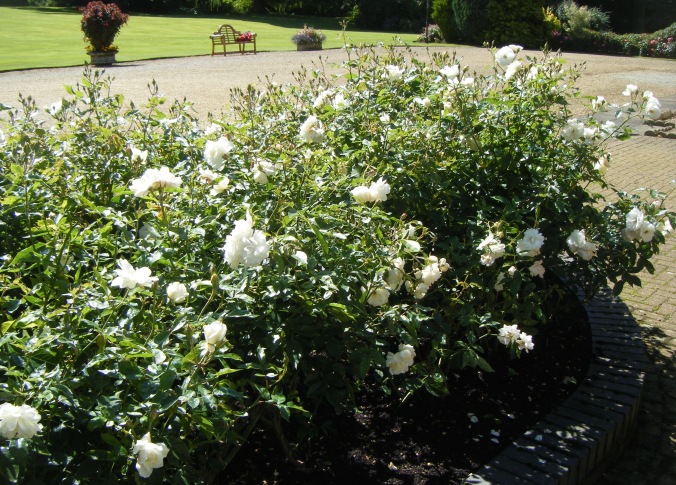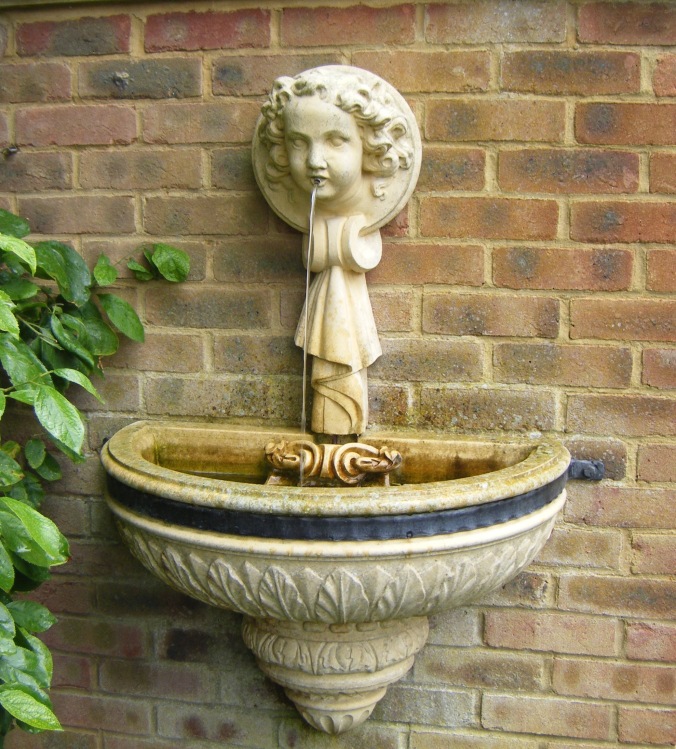East Haddon is a small attractive village 8 miles from Northampton and the graceful gates to the hall were wide open.

Old, old trees, with wide trunks and twisted branches survive along the drive,

and through the branches we are able to catch sight of the magnificent Georgian grade 1 listed building.

The garden first opened for the NGS in 1928 and was described in the Yellow Book as being surrounded by 8 acres of parkland; so I was surprised to find neatly mown lawns and not the grazed type of a country estate. I was worried that my interpretation of parkland was incorrect and a subsequent search in the Oxford dictionary provided me with the definition of parkland as ‘open grassy land with scattered groups of trees’, well, that is exactly what it is.
Set in the lawn to the left of the house, on the west side is a colourful circular border,

which can be reached from the ‘lion steps’. Before descending we stay on the path following the border of roses, still in bloom and the name of which the owner has sadly forgotten.

While the Squire Henry Sawbridge in 1780 chose his spot wisely, the view is magnificent,

the builder sensibly put no door on this northerly aspect. The present owner bought the house in 1989 and undertook much restoration to the house, he tells us that you can see the view right through from the front door.

An elegant fountain graces the centre of the sweeping lawns on the north side.

Returning along the west side a pink border is dominated by hydrangeas lies just below the low wall.

This is really the only part of the garden with flowers, recorded as having an input from the Lutyens/ Jekyll partnership, the sundial and steps appear to be the only remnants of the original design.

Further along and through the clumps of trees a willowy X marks the spot! Behind is an informal pond.

Mature trees spread out on the lawn and include this handsome Sweet Chestnut Castanea sativa, a tree thought to be introduced by the Romans it is not to be confused, and is no relation to the Horse Chestnut Aesculus hippocastanum which was first introduced from Turkey in the 16th Century.

From under the tree canopy we look towards the south side of the house. Used as a military hospital during the First World War, a maternity hospital during the second, it then became a girls school for some 20 years. What a medley of mankind have walked through that magnificent front door and enjoyed these grounds

Fresh white Iceberg roses with their lengthy flowering season are a good choice in front of the stable block built in the 1950s,

and a collection of geraniums brighten the yard between house and stables. Nothing beats the view through the modern archway.

The variety of stone and terracotta containers are overflowing.

It is containers, statues, fine garden ornaments and architectural stonework that we find across the road in the Haddonstone Show Garden.
The business which manufactures artificial stone was established in 1971 by Bob Barrow (1932 – 1996).

His Manor house where he lived with his family became the original showrooms displaying an increasing variety of ornamental and architectural cast stone. The Orangery stands at the end of the top lawn is serving teas in aid of the local school today.

Despite an air of commercialism you can feel that the series of gardens have been very much part of a family life.

Even on a wet day the pool is so inviting with its classical pillars clothed in climbers,

and these three ancients, Brutus, Bacchus and Bacchante, not known for their swimming skills, are keeping watch at the far end.
The sound of water is everywhere either gently spilling out over in the ‘Neapolitan’ fountain,

splashing down the tiers of the ‘Eton College Fountain’,

or simply spouting from mouths.

Areas divide into rooms which are either clipped and formal

or relaxed and free flowing.

The elements Earth, Air, Fire and Water are represented in these charming little guys who turn their backs to the tennis court and line the grassy pathway.
Each design is hand made using moulds created within the company’s studios and in time they weather to look like the natural stone.

The Regency Urn on a pedestal looks just as good empty as it does planted.

And why not give those doves a classical lift.

Powerful eagles, perhaps designed in mind for the American market, guard this rustic brick gateway.

Through the entwined and moss-covered branches of the apple orchard we are drawn towards a circular bed,

where ‘the Gardener’ stands amongst colourful cosmos. Was it his twin we spied in a similar situation up at the Hall?

It is not all stone ornament, a box topiary is taking shape

A path runs between the wooden pergola and perennial border and the Hadrian vase at the end becomes a focal point.

An entrance in the yew hedge bring us on to the middle lawn where a gothic jardiniere grandly fills the space.

Plants overflow from the ‘Raphael’ pool sited on the bottom lawn it is overlooked by the church tower of St. Mary the Virgin.

Will Shakespeare and Inigo Jones, the latest designs taken from the Sir John Soane Museum stand waiting to entertain diners on the patio by the house.

We cross the road to find the gate is open to the well-maintained Jubilee Garden, an overflow where yet more ornaments and structures can be found,

and the sound of water continues to be heard; the water tower built in 1890 and, I imagine, not for sale, stands high above the Bayeux Fountain on the lawn below, looking good with the spires of bold acanthus.

The classical pavilion is ready to complement the landscape of any stately home here or abroad,

whilst the ruined gothic grotto looks as though it has been here for years.

It is not just a show room but an English country garden.

The collection is vast and one might wonder why you would wish to adorn your garden with any one of these items. Consider for a moment the words of the designer David Hicks 1929 – 1998 which appear in the hefty Haddonstone brochure:
Garden ornaments provide emphasis and accent in a garden, drawing the eye in a particular direction. Most ornaments, because they are solid and static objects such as urns, seats, columns or statues provide a contrast with the living things around them.
Too large are the items to pop in the car but a pint sized owl, affordable too, is being offered for sale today, we can’t help thinking it is the wisest of purchases.

——-62 & 63 ——-







Love the Owl; where are you going to put him?
LikeLike
He is still flying around in search of a post!
LikeLike
With all of that encouragement I can see why you would come home with some object for the garden. I think you made the wisest choice. Quite a collection of garden schemes in this post. Enjoyed it all. If I had a pool I would love to have those pillars with the toppings of vines to have a cool retreat.
LikeLike
Again such wonderful photos. Love the chestnut tree and the vines around the pool are just glorious.
LikeLike
I think I am a little in love with the late Bob Barrow… such a great name and to see him perched on an urn… yes, love him!
LikeLike
Owls don’t migrate but, if he completely loses his way, there is a post in Cape Town being kept free of incoming migrating geese just for him.
LikeLike
Reading this very belatedly, and as usual, your photos are such a joy, and you wouldn’t even know it had been wet. Two fabulous settings, and what a plethora of ornaments – fun to see them and their founder in situ rather than lined up in a showroom.
LikeLike